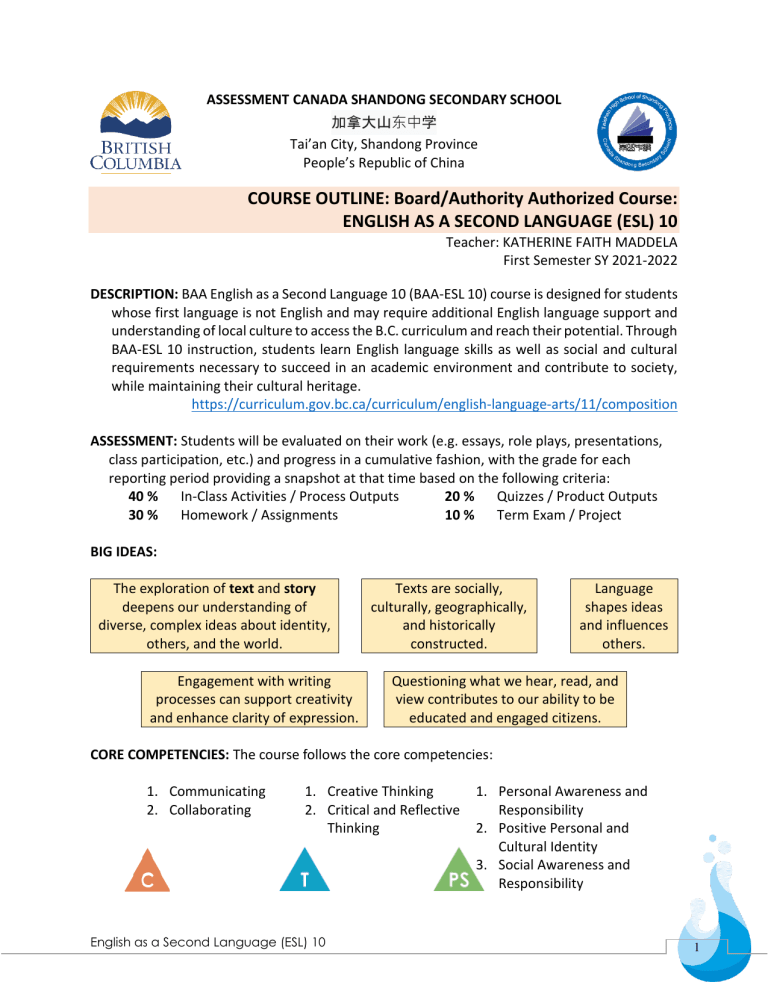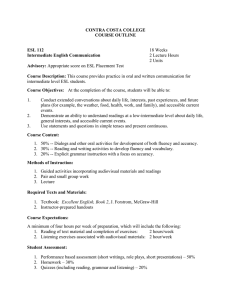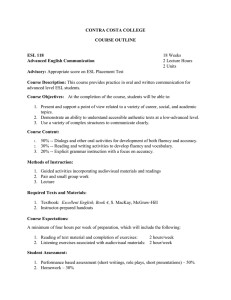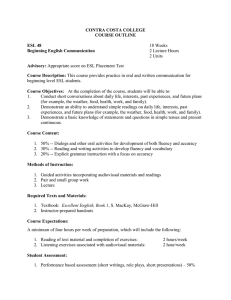
ASSESSMENT CANADA SHANDONG SECONDARY SCHOOL 加拿大山东中学 Tai’an City, Shandong Province People’s Republic of China COURSE OUTLINE: Board/Authority Authorized Course: ENGLISH AS A SECOND LANGUAGE (ESL) 10 Teacher: KATHERINE FAITH MADDELA First Semester SY 2021-2022 DESCRIPTION: BAA English as a Second Language 10 (BAA-ESL 10) course is designed for students whose first language is not English and may require additional English language support and understanding of local culture to access the B.C. curriculum and reach their potential. Through BAA-ESL 10 instruction, students learn English language skills as well as social and cultural requirements necessary to succeed in an academic environment and contribute to society, while maintaining their cultural heritage. https://curriculum.gov.bc.ca/curriculum/english-language-arts/11/composition ASSESSMENT: Students will be evaluated on their work (e.g. essays, role plays, presentations, class participation, etc.) and progress in a cumulative fashion, with the grade for each reporting period providing a snapshot at that time based on the following criteria: 40 % In-Class Activities / Process Outputs 20 % Quizzes / Product Outputs 30 % Homework / Assignments 10 % Term Exam / Project BIG IDEAS: The exploration of text and story deepens our understanding of diverse, complex ideas about identity, others, and the world. Engagement with writing processes can support creativity and enhance clarity of expression. Texts are socially, culturally, geographically, and historically constructed. Language shapes ideas and influences others. Questioning what we hear, read, and view contributes to our ability to be educated and engaged citizens. CORE COMPETENCIES: The course follows the core competencies: 1. Communicating 2. Collaborating 1. Creative Thinking 2. Critical and Reflective Thinking English as a Second Language (ESL) 10 1. Personal Awareness and Responsibility 2. Positive Personal and Cultural Identity 3. Social Awareness and Responsibility 1 FIRST PEOPLES’ PRINCIPLES OF LEARNING: The First Peoples Principles of Learning will be also play a large role in the learning that we do in the classroom. They are principles that help guide all of us in our life-long learning adventures. 1. Learning ultimately supports the well-being of the self, the family, the community, the land, the spirits, and the ancestors. 2. Learning is holistic, reflexive, reflective, experiential, and relational (focused on connectedness, on reciprocal relationships, and a sense of place). 3. Learning involves recognizing the consequences of one’s actions. 4. Learning involves generational roles and responsibilities. 5. Learning recognizes the role of indigenous knowledge. 6. Learning is embedded in memory, history, and story. 7. Learning involves patience and time. 8. Learning requires exploration of one’s identity. 9. Learning involves recognizing that some knowledge is sacred and only shared with permission and/or in certain situations. COURSE TOPICS: CURRICULAR CONTENT (Units Themes, Topics, and Focus) UNIT 1: Canadian and BC Culture - Writing: ideas and information, details and strategies, word choice - Reading: word attack skills, decoding and fluency - Oral Language: meaning, vocabulary, form - Cultural Studies: Canadian culture and BC culture UNIT 2: Indigenous and First Peoples’ Perspectives - Writing: sentence fluency, voice, organization and connection - Reading: comprehension (vocabulary, main ideas, genre) - Oral Language: meaning, vocabulary, form - Cultural Studies: indigenous and first peoples’ perspectives UNIT 3: History, Geography, and Government - Writing: (transition and cohesion, capitals and pronunciation, spelling) - Reading: comprehension (retelling, inferences, interpretations) - Oral Language: meaning, vocabulary, form - Cultural Studies: history and government, geography and mapping skills UNIT 4: Communication, Media, and Laws - Writing: (grammar and editing, word attack skills, decoding and fluency) - Reading: response & analysis (connections, opinions & reactions) - Oral Language: meaning, vocabulary, form - Cultural Studies: culture, communication, media, and laws English as a Second Language (ESL) 10 PERIOD (Time Frame) Weeks 1-5 Weeks 6-10 Weeks 11-15 Weeks 16-20 2 RESOURCES: https://www.englishclub.com/teach/teacherthemes.htm The Lighter Side of TEFL Headway Internet and webbased sources COURSE & CLASS EXPECTATIONS: The self-paced nature of this course requires that students manage their time effectively to complete the course by the deadline. Successful students make their own schedule to plan out the completion of the course. Students must read all the information and attempt all activities in the course in order to be successful in the course. Students must take care that their communication with the teacher and with other students (through email, class app message, or in person) is course related, clear and respectful. Students must ascertain that their work is their own and not plagiarized from any other source. This includes previous work submitted for another course, other people’s assignments, Web or other resources etc. Acknowledgment of sources is highly appreciated. MARKING SCALE Students’ marks are based on the grades they receive on a particular assignment, participation in class activities, proficiency to work in group, and ability to think about own learning. Letter Grade A B C+ C CI/F Indicator Extending (Ext) Proficient (Pro) Developing (Dev) Emerging (Em) Emerging (Em) Incomplete / Failing Description Excellent Quality Very Good Quality Good Quality Satisfactory Quality Minimal Quality Failure Percentage 86-100% 73-85% 67-72% 60-66% 50-59% 0-49% KatherineMaddela@cseec.education WeChat: MissKMaddela English as a Second Language (ESL) 10 3



